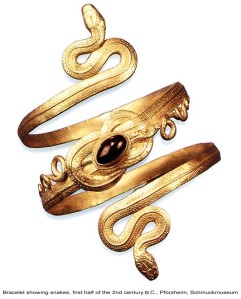Dating back over 7,000 years, the origin of the bracelet began in ancient Egypt and quickly popularized in ancient China. Originally made with various materials

Ancient Egyptian Wood Bracelet
such as wood, bone and plant fibers… bracelet makers in Egypt and all over Africa eventually discovered how to mold bronze and copper to create these famous accessories. In 2000 BC, China produced the first known innovation to the original design with jade and elaborate gold bracelets. Mesopotamia soon followed with a gold bracelet design of their own. Jealous of the intricate bracelets worn by the Chinese, the pharaohs and emperors of Egypt demanded even more detailed bracelets which quickly led to the invention of charm bracelets with tiny trinkets dangling from the gold bands.
Following these events, the popularity of bracelets in ancient Babylon exploded which resulted in the spreading of this fad throughout Europe. The bracelet styles of choice were bangle bracelets and simple cuff Bracelet styles; leaving the lavish charm bracelets to the Egyptian Pharaohs. At the same time, the Greeks created bracelets with various animals such snakes and lions. Greek women favored gold and silver bracelets worn both on the upper arm and around their wrist. Greek soldiers turned the fashion statement into a form of armor and adorned their ceremonial attire with thick, leather bracelets.
and simple cuff Bracelet styles; leaving the lavish charm bracelets to the Egyptian Pharaohs. At the same time, the Greeks created bracelets with various animals such snakes and lions. Greek women favored gold and silver bracelets worn both on the upper arm and around their wrist. Greek soldiers turned the fashion statement into a form of armor and adorned their ceremonial attire with thick, leather bracelets.
Romans, who were famously obsessed with jewelry, took to the creation of bracelets like wildfire. The Romans favored thin, coiled bangle bracelets made  of copper or solid gold. Inspired by the Greeks, the Romans added heads of animals to their coiled bangles and favored designs with lions and wolves. One of the most popular cuff bracelets of the era was of two snakes coiled around each other creating the band of a cuff bracelet. The Romans were also one of the first to wear gemstone bracelets as well as the popular knot bracelet which is found in designer jewelry today.
of copper or solid gold. Inspired by the Greeks, the Romans added heads of animals to their coiled bangles and favored designs with lions and wolves. One of the most popular cuff bracelets of the era was of two snakes coiled around each other creating the band of a cuff bracelet. The Romans were also one of the first to wear gemstone bracelets as well as the popular knot bracelet which is found in designer jewelry today.










